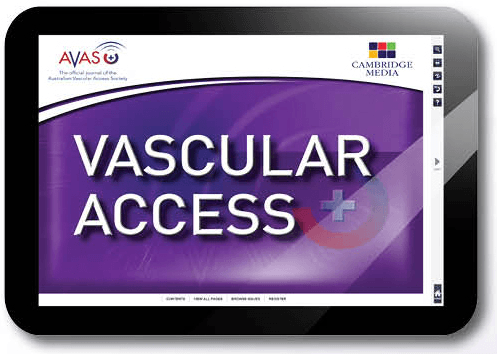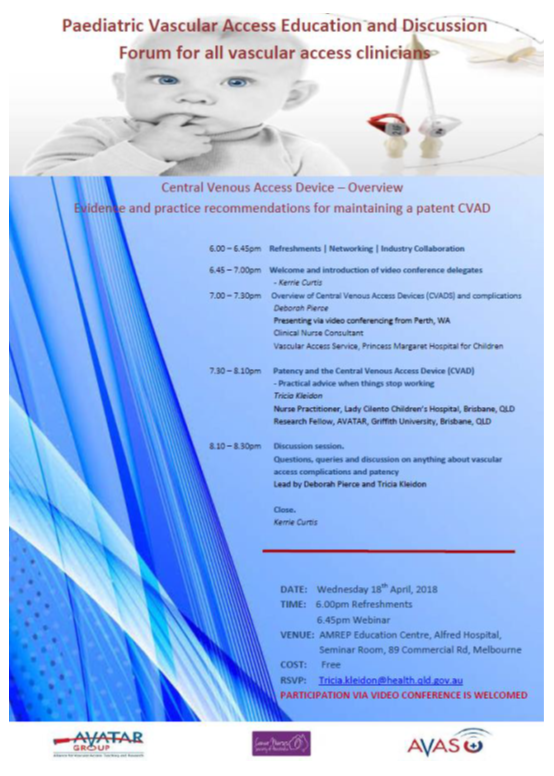Vascular Access: April edition out now
Posted
on 17 April 2018
VASCULAR ACCESS, April edition of the peer-reviewed multidisciplinary official journal of the Australian Vascular Access Society (AVAS) is now available!
Table of contents
Woods C, Ray-Barruel G, Marsh N, Flynn J, Larsen E, Rickard CM. Registered nurses' experiences of using four methods of peripheral intravenous catheter dressings and securement during a randomised controlled trial. A survey. Vascular Access 2018;4(1)
Abstract:
Background: Peripheral intrave...
| Posted in:central vascular access devicesintravenous catheterIV managementvascular access devices |
Paediatric Vascular Access Education and Discussion Forum for all vascular access clinicians
Posted by Rita Nemeth
on 10 April 2018
| Posted in:AVATARIV managementvascular access devices |
Webinar Invitation: March 9, 2018 Preventing harm for our patients: Recognising, preventing and treating medical adhesive-related skin injury (MARSI)
Posted
on 22 February 2018
Webinar Invitation: March 9, 2018
3M Health Care Academy Webinar Series
Preventing harm for our patients: Recognising, preventing and treating medical adhesive-related skin injury (MARSI)
Register Everyday, patients develop skin injuries and irritations related to the application and removal of medical adhesives. Many medical adhesive-related skin injury (MARSI) are preventable, almost all are treatable. Each are associated with significant discomfort, and someti...
Preventing harm for our patients: Recognising, preventing and treating medical adhesive-related skin injury (MARSI)
Register Everyday, patients develop skin injuries and irritations related to the application and removal of medical adhesives. Many medical adhesive-related skin injury (MARSI) are preventable, almost all are treatable. Each are associated with significant discomfort, and someti...
| Posted in:AVATARdressingsinfection preventionsecurement |
Whose line is it anyway?
Posted by Rita Nemeth
on 21 February 2018
The Intensive Care Foundation and AVATAR are pleased to present our second collaborative seminar on 26 March 2018
Glass Viewing room at Queensland Cricketers' Club
411 Vulture Street, The Gabba, Woollongabba
Intensive care patients are cared for by a multi-disciplinary team, each of whom have distinct and important contributions to the complex journey, taking the patient from critically ill through to discharge.
Along this journey, patients will have multiple vascular a...
Along this journey, patients will have multiple vascular a...
| Posted in:AVATARcentral vascular access devicesdressingsflushinginfection preventionintravenous catheterIV managementpatient experiencephlebitissecurementvascular access devices |
VASCULAR Study
Posted by Rita Nemeth
on 21 February 2018
Assessing vascular access in Latin America. The VASCULAR (Vascular AccesS Catheter Use in Latin AmeRica) study is a multinational cross-sectional study designed to assess and compare the prevalence of PIVC use in Latin American hospitals, to benchmark quality care practices, and to determine the proportion of complications leading to PIVC failure.
| Posted in:central vascular access devicesintravenous catheterIV managementvascular access devices |
Vascular Access: Call for Papers
Posted by Gillian Ray-Barruel
on 15 December 2017
)
Vascular Access Call for Papers! Submission deadline 1 February 2018.
Did you know, the Australian Vascular Access Society has its own peer-reviewed online journal, Vascular Access? http://avas.org.au/avas-journal/
The electronic journal is published twice a year in April and October, and we warmly welcome research findings, clinical papers, case studies, reports, review articles, letters and product appraisals pertaining to this specialty. Video submissions are also welcomed. Submis...
| Posted in:AVATARcentral vascular access devicesintravenous catheterIV managementvascular access devices |
Australian Vascular Access Society (AVAS)
Posted
on 15 December 2017
The Australian Vascular Access Society (AVAS) is an association of healthcare professionals founded to promote the vascular access specialty.
Our multidisciplinary membership strives to advance vascular access research, promotes professional and public education to shape practice and enhance patient outcomes, and partners with industry to develop evidence-based innovations in vascular access.
The electronic journal Vascular Access is the official publication of AVAS, and provi...
| Posted in:central vascular access devicesintravenous catheterIV managementvascular access devices |
Holiday Greetings from the AVATAR Group
Posted
on 15 December 2017
Merry Christmas and a Happy 2018 to all AVATAR staff, students, friends and partners around the world!
We take this time to thank you for your commitment to making vascular access complications history.
And, we look forward to working with you in 2018 to continue to improve consumer experiences and clinical outcomes of vascular access and infusion therapy.
Our congratulations to the following who will receive a certificate and support to present their vascular access findings a...
| Posted in:AVATARvascular access devices |
Substantial harm associated with failure of chronic paediatric central venous access devices.
Posted by Amanda Ullman
on 13 September 2017
Ullman AJ, Kleidon T, Cooke M, Rickard CM. Substantial harm associated with failure of chronic paediatric central venous access devices. BMJ Case Reports. 2017.
Central venous access devices (CVADs) are essential to modern paediatric healthcare, however device complications and failures remain high. This case study illustrates the complex and harmful experience of a young child with CVAD dependency and failure due to 'short gut syndrome' (significant bowel resection as a result...
| Posted in:AVATARcentral vascular access devicesinfection preventionIV management |
Evidence Update 2017
Posted
on 1 September 2017
Please, click here for more information about the AVATAR Evidence Update 2017
| Posted in:AVATARinfection preventionintravenous catheterIV managementpatient experiencesecurementvascular access devices |









